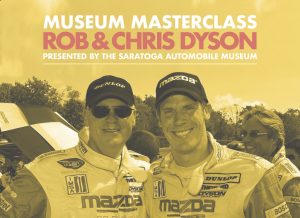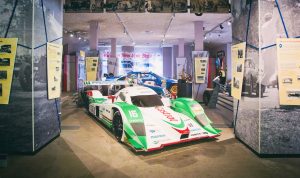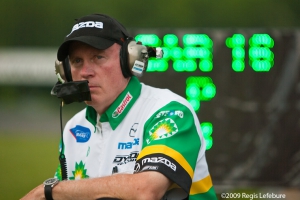New venues help keep racing fresh. In the American Le Mans Series, there have been five new races in the past six years: Baltimore, St. Petersburg, Salt Lake City, Long Beach and Houston. A new track presents a whole different set of challenges to a race team. This year, the street track in downtown Baltimore was a successful addition to the ALMS season. We asked Dyson Racing’s Technical Director, Peter Weston, how you approach a circuit that the team has never seen before.
“A new circuit is a terrific leveler for all concerned: the team, drivers and engineers. You have to pick up any morsel of information you can about the circuit and try to get ahead of the game. I will use Google Earth to get point-to-point measurements around the track. I contacted the circuit organizers and got a map of the design of the track to get corner radiuses and other track measurements. A little bit of local knowledge is also good if you have people on the ground that can go take a look at the track and see what the surface is like.
“Making sure you do not make a mistake on the gearing is very important. There is nothing worse than going to a brand new track and having your driver ring you up half way down the back straight and saying that he is on the rev limiter. You have very little time at a new track without having to take time out to change the gearing during a session. So I do point to point measurements between the primary corners to try and ascertain what sort of gear we are going to be arriving at each corner in, and at what speed. We know the acceleration of the car from past data, so that gets figured in also.
“In general at street tracks, aerodynamically, more downforce is going to be faster. It was like that in Houston and to a lesser degree, Long Beach. Long Beach is a unique street track because of the length of the pit straight, so you tend not to run maximum downforce there. Mostly street tracks are point and squirt. Relatively slow corner speeds are the norm, so downforce at low speeds is the key.
“So a track map will give you an idea of what kind of course it is going to be. You can see where the primary overtake points are going to be, and where the intersections are where there might be large bumps. And if you can get some advance knowledge about the surface of the circuit, that is absolute gold because street tracks can be bumpy and very smooth at the same time: bumpy from a bouncing around stand point, and yet smooth in terms of the surface which has often been polished by years of traffic. It is not unusual for street circuits to be a mix of concrete and asphalt. Knowing that mix will tell you and the drivers what kind of surface they will be dealing with at each individual corner.
“So it comes down to giving the drivers the most drivable package you can off the truck so you are not wasting time in the pits making too many adjustments and the driver can just spend his time learning the track. At Baltimore this year, we had one abbreviated session before qualifying. So maximizing your time on a new track is critical.
When asked about his pole qualifying effort at Houston in 2006, the first time for the ALMS at the street track, James Weaver said, “I think one of the reasons we are quick here is that the Dyson team has always been good at arrive-and-drive races. The team is excellent with a limited amount of time in making the right calls and the right judgments. When you cannot engineer the car to death, you have to draw upon years of experience and I think that is when you see how much strength and depth there is at Dyson Racing.”
And from a driver’s viewpoint, what are the first laps of the first practice session at new track like? Long time Dyson driver, Butch Leitzinger, talked about the team’s first time at the iconic Long Beach track in 2007.
“Any time you are on a new street circuit, you have to know that the track has very little rubber laid down and has very little grip. We push the traction control up to maximum so it will save you, because on cold tires, the car is already trying to spin on you. And even with that, the first couple of turns, it jumps out on you a couple of places and your heart rate goes up and you hope that Rob is not watching that corner on the monitors back in the pits!
“After a lap or two, the brake markers start to click in and than the thing that takes the longest is getting heat in the tires. Until you do that, it rides a bit lower than at operating pressure, so it hits the ground in some places, and you have to let them come up to temperature before you drive the car hard. On a green track, that is usually around three laps. Than you are turning down the traction control so that by the end of the session you are running about a third of what you started with. At that point, you are able to drive it pretty hard and get in a representative lap.
“One of the easier parts of the process is figuring out how late you can brake. From experience and judging the turn and your speed, you are able to figure how deep you can go in pretty close to where you will do it the rest of the weekend. What takes the most time though, is figuring how much momentum and speed you can carry through the corner, especially on the street course, without smacking the wall. On a road course you can take a few more chances early on because if you make a mistake, you might go off on the grass a little bit. But on a street course, the concrete walls restrain you on how long it takes you to be fast.
“So at this point, your times are coming down and getting faster each lap. But after three or four laps, you are starting to come up to traffic, coming up on the GT cars that are trying to find their way around. So than you start figuring out good places to pass, trying to evaluate where you can pass cleanly, where it is impossible, and where, when everything is right, you might be able to get by.
You will not see this not so much in the lap times at this point as you will by your more focused feel and judgment. During this whole time, you are also trying to figure out where the car is at a disadvantage, where you are loosing time, and what exactly the car is doing so you can communicate that to the race engineer. But you have to be sure that it is not that the tires are not hot yet, or at the right pressure, or the ride heights are too low because that will send you down the wrong road on set up. You will go on a wild goose chase and end up fixing problems that are not there when everything is working right. So once again, it is important to give it a few laps to make sure everything is at operating temperatures.
“Normally, after about ten minutes, you come in, download to the race engineer what the car is doing and make some changes and than go out again and see if it has improved in places it needed to improve and has not hurt it in places where it was already OK”.
“At this point, you are not at a good qualifying level of confidence because for qualifying you are really pushing it to the edge. You are at a level that would not be too bad going into the race with, because in the race, at least at the beginning, you can scale it back a little bit to make sure you stay out of trouble. As the race goes on, you are getting more experience and getting more comfortable with the car, so by the end of the race you will be fine.”
At the Baltimore Grand Prix this year, the results bore out James Weaver’s observations at Houston back in 2006 about the ability of Dyson Racing to adapt to new tracks well. Dyson Racing qualified first and second and finished first and second, giving the #20 Oryx Dyson Racing entry its first American Le Mans victory at the track that ran around the Oriole Park at Camden Yards. To borrow the local baseball parlance: it was a weekend of batting a thousand.


